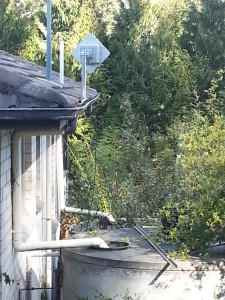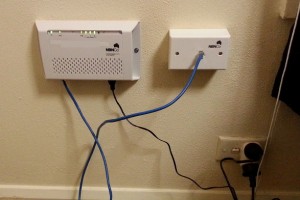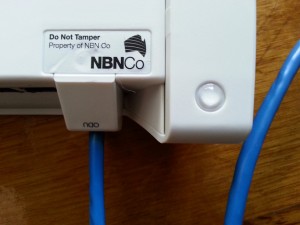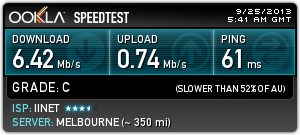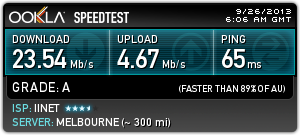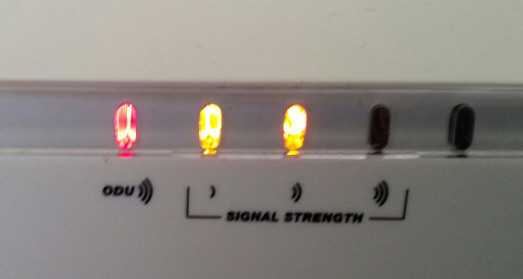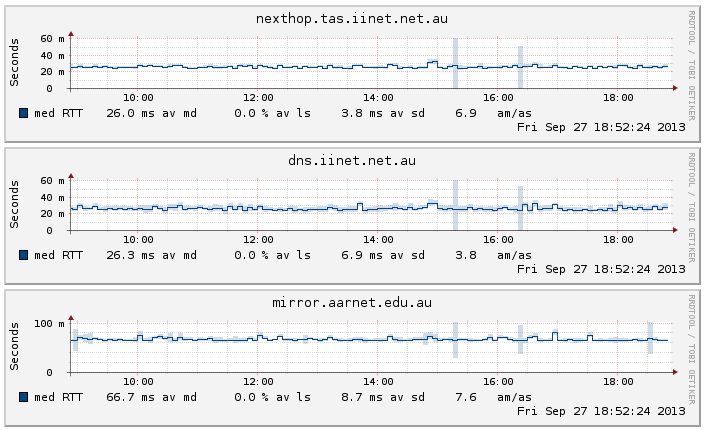To my intense amazement, it seems that NBN Co have finally done sufficient capacity expansion on our local fixed wireless tower to actually resolve the evening congestion issues we’ve been having for the past couple of years. Where previously we’d been getting 22-23Mbps during the day and more like 2-3Mbps (or worse) during the evenings, we’re now back to 22-23Mbps all the time, and the status lights on the NTD remain a pleasing green, rather than alternating between green and amber. This is how things were way back at the start, six years ago.
Tag Archives: telework
Herringback
It occurs to me that I never wrote up the end result of the support ticket I opened with iiNet after discovering significant evening packet loss on our fixed wireless NBN connection in August 2017.
The whole saga took about a month. I was asked to run a battery of tests (ping, traceroute, file download and speedtest, from a laptop plugged directly into the NTD) three times a day for three days, then send all the results in so that a fault could be lodged. I did this, but somehow there was a delay in the results being communicated, so that by the time someone actually looked at them, they were considered stale, and I had to run the whole set of tests all over again. It’s a good thing I work from home, because otherwise there’s no way it would be possible to spend half an hour three times a day running tests like this. Having finally demonstrated significant evening slowdowns, a fault was lodged, and eventually NBN Co admitted that there was congestion in the evenings.
NBN Fixed Wireless – Four Years On
It’s getting close to the fourth anniversary of our NBN fixed wireless connection. Over that time, speaking as someone who works from home, it’s been generally quite good. 22-24 Mbps down and 4-4.5 Mbps up is very nice. That said, there have been a few problems along the way, and more recently evenings have become significantly irritating.
There were some initial teething problems, and at least three or four occasions where someone was performing “upgrades” during business hours over the course of several consecutive days. These upgrade periods wouldn’t have affected people who are away at work or school or whatever during the day, as by the time they got home, the connection would have been back up. But for me, I had to either tether my mobile phone to my laptop, or go down to a cafe or friend’s place to get connectivity.
There’s also the icing problem, which occurs a couple of times a year when snow falls below 200-300 metres for a few days. No internet, and also no mobile phone.
These are all relatively isolated incidents though. What’s been happening more recently is our connection speed in the evenings has gone to hell. I don’t tend to do streaming video, and my syncing several GB of software mirrors happens automatically in the wee hours while I’m asleep, so my subjective impression for some time has just been that “things were kinda slower during the evenings” (web browsing, pushing/pulling from already cloned git repos, etc.). I vented about this on Twitter in mid-June but didn’t take any further action at the time.
Several weeks later, on the evening of July 28, I needed to update and rebuild a Ceph package for openSUSE and SLES. The specifics aren’t terribly relevant to this post, but the process (which is reasonably automated) involves running something like `git clone git@github.com:SUSE/ceph.git && cd ceph && git submodule update --init --recursive`, which in turn downloads a few GB of data. I’ve done this several times in the past, and it usually takes an hour, or maybe a bit more. So you start it up, then go make a meal, come back and you’re done.
Not so on that Friday evening. It took six hours.
I ran a couple of speed tests:
I looked at my smokeping graphs:
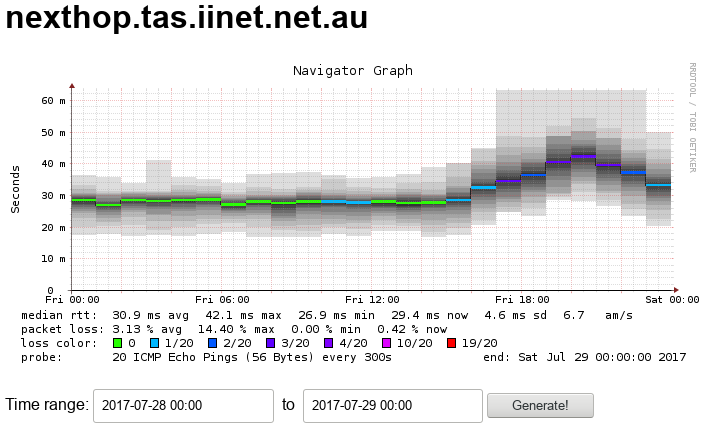
That’s awfully close to 20% packet loss in the evenings. It happens every night:
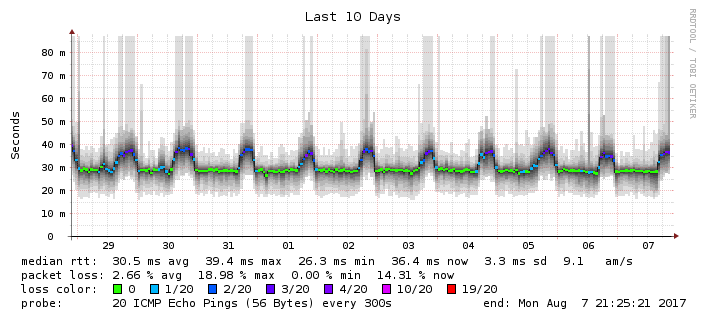
And it’s been happening for a long time:
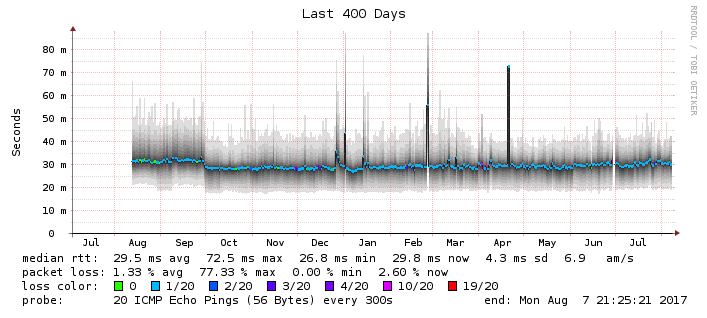
Right now, as I’m writing this, the last three hours show an average of 15.57% packet loss:
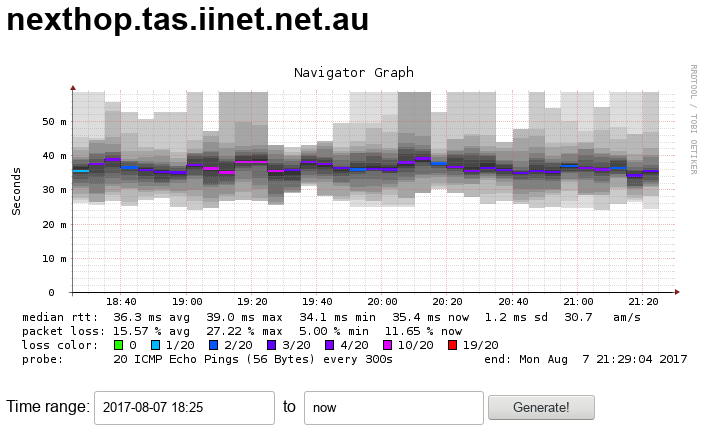
So I’ve finally opened a support ticket with iiNet. We’ll see what they say. It seems unlikely that this is a problem with my equipment, as my neighbour on the same wireless tower has also had noticeable speed problems for at least the last couple of months. I’m guessing it’s either not enough backhaul, or the local NBN wireless tower is underprovisioned (or oversubscribed). I’m leaning towards the latter, as in recent times the signal strength indicators on the NTD flick between two amber and three green lights in the evenings, whereas during the day it’s three green lights all the time.
I Want My… I Want My… NBN
I thought I’d start this post with some classic Dire Straits, largely for the extreme tech culture shock value, but also because “MTV” has the same number of syllables as “NBN”. I’ll wait while you watch it.
Now that that’s out of the way, I thought it might be interesting to share my recent NBN experience. Almost a year ago I said “Yay NBN! Bring it on! Especially if I don’t get stuck on satellite”. Thankfully it turns out I didn’t get stuck on satellite, instead I got NBN fixed wireless. For the uninitiated, this involves an antenna on your roof, pointed at a nearby tower:
An NTD (Network Terminating Device) is affixed to a wall inside your house:
The box on the left is the NTD, the box on the right is the line from the antenna on the roof. Not pictured are the four ports on the bottom of the NTD, one of which is now plugged into a BoB Lite from iiNet. According to the labels on the NTD, the unit remains the property of NBN Co, and you’re not allowed to tamper with it:
Getting online is easy. Whatever you plug into the NTD just gets an IP address via DHCP – there’s none of that screwing around with PPPoE usernames and passwords. The BoB Lite lets you configure one of its ethernet ports as a “WAN source” instead of using ADSL, which is what I’m doing. Alternately you could plug in a random Linux box and use that as a router, or even just plug your laptop straight in, which is what I did later when trying to diagnose a fault.
The wireless itself is LTE/4G, but unlike 4G on your mobile phone (which gets swamped to a greater or lesser degree when lots of people are in the same place), each NBN fixed wireless tower apparently serves a set number of premises (see the fact sheet PDF), so speed should remain relatively consistent. Here’s the obligatory speed tests, first from my ADSL connection:
And here’s what I get via NBN wireless:
Boo-yah!
Speaking as someone who works from home and who has to regularly download and upload potentially large amounts of data, this is a huge benefit. Subjectively, random web browsing doesn’t seem wildly different than before, but suddenly being able to download openSUSE ISOs, update test VMs, and pull build dependencies at ~2 megabytes per second has markedly decreased the amount of time I spend sitting around waiting. And let’s not leave uploads out of the picture here – I push code up to github, I publish my blog, I upload tarballs, I contribute to wikis. I’ve seen too much discussion of FTTP vs. FTTN focus on download speed only, which seems to assume that we’re all passive consumers of MTV videos. OK, fine, I’m on wireless and FTTP is never going to be an option where I live, but I don’t want anyone to lose sight of the fact that being able to produce and upload content is a vital part of participating in our shiny new digital future. A reliable connection with decent download and upload speed is vital.
Now that I’ve covered the happy part of my NBN experience, I’ll also share the kinks and glitches for completeness. I rang up to get connected on August 1st. At the time, the next available installation appointment was August 21st. On that day I got a call saying the technician wouldn’t be able to make it because his laptop was broken. I offered to let them use my laptop instead, but apparently this isn’t possible, so the installation was rescheduled for September 6th. All attempts at escalating this (i.e. getting the subsequent 2.5 week delay reduced, because after all it was their fault they had a broken laptop) failed. By the time the right person at iiNet was able to rattle enough sabres in the direction of NBN Co, the new installation date was close enough that it didn’t make a difference anymore. To be clear, as far as I can tell, iiNet is not at fault; the problem seems to be one of bureaucracy combined with probable understaffing/overdemand of NBN Co (apparently this newfangled interwebs thingy is popular). As an aside, I mentioned the “broken laptop” problem to a friend, who said a friend of his had also had installation rescheduled with the same excuse. I’m not quite sure what to make of that, but I will state for the record that I seriously doubt our new fearless leaders would have been able to make matters any better had they been in power at the time.
Anyway, installation finally went ahead and all was sweetnees and light for just under three weeks, until one of those wacky spring days where it’s sun, then howling wind, then sideways rain, then sun again, then two orange signal strength lights and a red ODU light:
ODU stands for Outdoor Unit, which is apparently the antenna. For at least an hour, the lights cycled between red and green ODU, and two orange / three green signal strength. Half an hour on the phone to iiNet support, as well as plugging a laptop directly into the NTD didn’t get me anywhere. I managed to get a DHCP lease on my laptop very briefly at one point, but otherwise the connection was completely hosed. The exceptionally courteous and helpful woman in iiNet’s Fibre team logged a fault with NBN Co, and I switched my ADSL – which I had kept for just such an emergency – back on, so that I could get some work done.
The next day everything was green, so I plugged back into the NTD. About an hour after this, I got a call from the same woman at iiNet saying they’d noticed I had a connection again and had thus cancelled the fault, but that she was going to keep an eye on things for a little while, and would check back with me over the next week or two. I also received an SMS with her direct email address, so I can advise her of any further trouble. I’ve since got smokeping running here against what I hope is a useful set of remote hosts so I’ll notice if anything goes freaky while I’m asleep or otherwise away from my desk:
I really wish I knew how to get a console on the NTD, or view some logs. I was told it’s basically a dumb box, but surely it knows a bit more internally than it indicates on the blinkenlights. As I said on twitter the other day, I feel like a mechanic trapped in the drivers seat of a car, with access only to the dashboard lights. Oh, well, fingers crossed…
Telework, Telework and the NBN
A few related (or semi-related) bits and pieces which turned up over the last month or so. The first is a video I was sent from onlinemba.com, entitled Telecommuting is Good for You and Good for Business. It cites a few studies showing greater productivity, reduced turnover and eco-friendliness (which I would tend to agree with based on personal experience). Unfortunately I can’t seem to see links to the studies themselves, but you should go watch it anyway, because it’s one of those cute “live animated” things, which I’m a sucker for.
That leads neatly to the second thing, which is from the iiNet blog, entitled The benefits of working from home. As with the above video, Yahoo gets a prominent mention for not allowing telework (although reports on that seem to be somewhat mixed). Anyway, benefits cited include lack of commute, lower overhead and fewer distractions, but the blog post does also make the very good point that you need to figure out whether or not telework is actually right for you. It also offers some tips I tend to agree with.
Now we get to the semi-related bit. Assuming telework is right for you, you want a good internet connection. As I’ve said before, “Yay NBN! Bring it on!“. As much disenchantment as I have with the major parties, this is something Labor is actually doing right. For an easy-to-appreciate comparison of what Labor and the LNP are proposing, check out How Fast is the NBN. Teleworkers, pay particular attention to the simulated Dropbox sync.
How to Stay Sane and Productive While Hacking FOSS on a Farm
Following is a transcript of the talk I gave at OSDC 2012. It has been edited slightly for clarity, but should otherwise be a reasonably faithful reproduction. For those following along at home, I’m sorry the slides are all images, even when they consist only of text. If there’s a better way of integrating an export from LibreOffice Impress with a hand-tooled transcript, I’m all ears. Otherwise, here goes…


